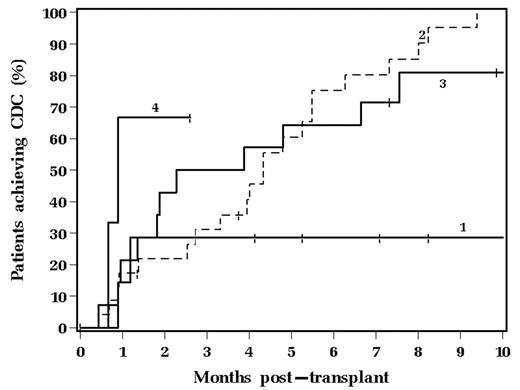Abstract
The reactivity of NK cells and some T cell populations is regulated by KIR interactions with HLA class I molecules. Such interactions have been suggested to influence outcomes after myeloablative allogeneic HSCT. However, in NMHSCT the effect of KIR interactions on outcomes including the development of CDC has not been well described. We analyzed 51 pts who received related donor NMHSCT at our institution from 1/10/00–10/25/05. All pts received fludarabine 30 mg/m2/d x 3 days followed by total body irradiation 200 cGy (n=35) or 400 cGy (n=16) for conditioning. The median age was 54 (range, 21–64). Short tandem repeat analysis for T cell (CD3+) chimerism was performed on peripheral blood and CDC was defined as achievement of >95% DNA of donor origin in the CD3+ T cells. 37 (73%) of patients achieved CDC at a median time of 3.3 mos (range, 0.4–11.2). KIR genotypes were determined for recipients by PCR-rSSOP analysis. Donor HLA KIR ligands were categorized as:
HLA-Cw groups C1 (+ or −);
C2 (+ or −);
HLA-Bw4 (+ or −); and
HLA-A3 or -A11 (+ or −) [as reviewed by
Farag et al. Blood 2002; 100:1935–47].
Recipient KIR genotype and donor HLA KIR ligands were used to generate an inhibitory KIR score for pts from 1 to 4 corresponding to the potential number of inhibitory KIRs engaged. 7 pts had a score of 1, 27 had a score of 2, 14 had a score of 3 and 3 had a score of 4.
The Kaplan-Meier method was used to estimate the achievement of CDC by inhibitory KIR score (figure, p=0.09). Pts with a score of 1 were less likely to achieve CDC compared to those with a score of 2 (p=0.02), while those with a score of 2 tended to be less likely to develop CDC than those with a score of 4 (p=0.07). There were no differences in CD34+ or CD3+ cell doses between any of the groups. When combined with the inhibitory KIR score data the presence of single or multiple activating KIR’s was not found to influence the development of CDC. Thus, pts with lower inhibitory KIR scores may have more active anti-donor effector cells (NK cells and T cell subsets) that may reduce donor cell chimerism. Conversely, those with higher inhibitory KIR scores may have less active populations and be more likely to achieve CDC. Given the genotypic potential to inhibit all NK cells KIR expression may be variable among different clones, and may affect the development of CDC. Further investigation of KIR expression at the cellular level rather than by genotyping alone should be pursued.
Disclosure: No relevant conflicts of interest to declare.
Author notes
Corresponding author


This feature is available to Subscribers Only
Sign In or Create an Account Close Modal